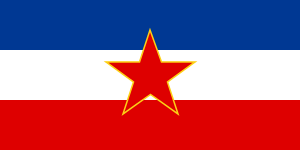M74/M75 mortar
| 120 mm M74 and M75 Mortars | |
|---|---|
|
| |
| Type | Mortar |
| Place of origin |
|
| Service history | |
| In service | 1981-present |
| Used by | see below |
| Wars | Yugoslav Wars |
| Production history | |
| Designer | Military Technical Institute Belgrade |
| Specifications | |
| Weight | 105 kg for M74, 177 kg for M75 in firing position |
| Crew | 5 |
|
| |
| Caliber | 120 millimetres (4.7 in) |
| Rate of fire | 12 rpm for M74, 15 rpm for M75 |
| Effective firing range | 6400m for M74, 9056m for M75 |
| Feed system | manual |
The M74 and M75 are second generation 120 mm caliber mortars built in Yugoslavia.[1]
The M75 model is heavier and deployed to provide fire support in infantry battalions. M75 in comparison to M74 weighs more, but provides greater rate of fire and possibility of longer firing period. On the other hand M74 can be carried and dismantled by three crew attendants.
Mortar M74 is generally deployed for one or two fire strikes with 15 to 20 shells, while M75 is deployed in artillery for 60-minute firing periods. Both mortar models entered serial production in 1981.
Mortars in former Yugoslavia were considered to be very important arms as they are very effective and simple to use weapons deployed in fire support role.
Today they are produced by Serbian company PPT Namenska,[2] and BNT[3] form Bosnia and Herzegovina.
Purpose
Deployed as infantry support for destruction of personnel and enemy firing positions, for opening routes through barbed wire obstacles and mine fields, for demolition of fortified objects, for destructing infrastructure elements, illumination and deploying smoke screen.
Ammunition
HE Mortar Shell[4]
- 120 mm HE Mortar Shell Mk12P1-L
- 120 mm HE Mortar Shell M62P8
Smoke Mortar Shell[5]
- 120 mm High-Smoke Mortar Shell M89
- 120 mm Smoke Mortar Shell M64P2
- 120 mm Smoke Mortar Shell M64P3
- 120 mm Smoke Mortar Shell Mk12
- 120 mm Smoke Mortar Shell Mk12-L
Illuminating Mortar Shell[6]
- 120 mm Illuminating Mortar Shell M91
- 120 mm Illuminating Mortar Shell M87P1
Users
-
 Yugoslavia
Yugoslavia  : Serbian Army
: Serbian Army  : Croatian Army
: Croatian Army : Armed Forces of Bosnia and Herzegovina
: Armed Forces of Bosnia and Herzegovina  : Iraqi Army
: Iraqi Army-
 Georgian Army: 45 M-75 mortars were delivered from Bosnia and Herzegovina[7] and 25 M-75 mortars were delivered in 2005 from Czech Republic[7][8]
Georgian Army: 45 M-75 mortars were delivered from Bosnia and Herzegovina[7] and 25 M-75 mortars were delivered in 2005 from Czech Republic[7][8]
References
- ↑ "Yugoslavian mortars - List of mortars developed in Yugoslavia".
- ↑ "PPT - Production capacities".
- ↑ "BNT - BNT military production".
- ↑ "Krusik HE - HE mortar shell".
- ↑ "Krusik Smoke - Smoke mortar shell".
- ↑ "Krusik Illuminating - Illuminating mortar shell".
- ↑ 7.0 7.1 О военной помощи Грузии со стороны иностранных государств // "Зарубежное военное обозрение", № 6 (735), 2008. стр.94-95
- ↑ UN Register - Georgia Standard Report. (Import, Calendar Year 2005)